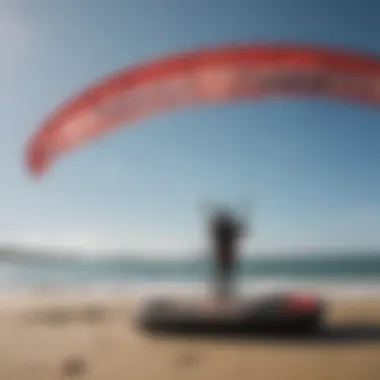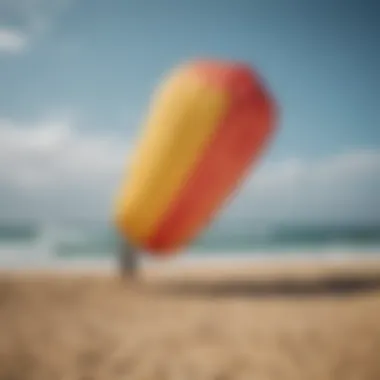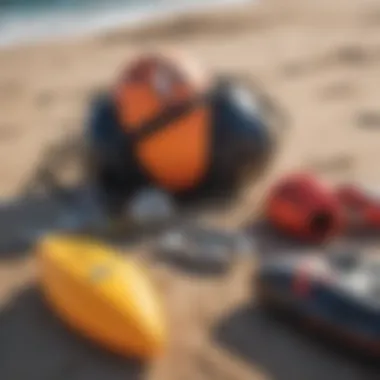A Comprehensive Guide to Inflatable Kites


Intro
In the lively world of kiteboarding, inflatable kites have carved out a solid place for themselves, captivating both novice and seasoned riders alike. Their versatility, ease of use, and enhanced performance characteristics differentiate them from traditional kites. Whether you're slicing through waves or floating above them, the right inflatable kite can make all the difference. But with so many options available, making an informed choice can feel like navigating a minefield. This article aims to shed light on the diverse range of inflatable kites up for sale, explaining their distinguishing features, critical considerations for potential buyers, and the overall dynamics of the sport.
Gear Selection
Types of Kites
Inflatable kites primarily come in three types: hybrid, free ride, and race kites. Each has its unique qualities, tailored to meet various riding styles and preferences. Hybrid kites, for example, blend characteristics from different types, offering a balance of performance and stability. They can be a great choice for those still honing their skills.
Free ride kites are versatile and cater to a wide array of riding conditions. These are often favored by those who enjoy all-round sessions on the water. With a focus on comfort and control, free ride kites can really enhance a rider's overall experience.
For those looking to push the envelope, race kites are designed for speed and performance. They require precise skills and offer minimal drag, making them ideal for experienced riders pursuing competitive performance.
- Hybrid Kites: Great for beginners, all-round performance
- Free Ride Kites: Versatile, caters to many styles
- Race Kites: For the speedsters, designed for minimal resistance
Choosing the Right Board
Selection of a board goes hand-in-hand with picking a kite. This pairing is essential for realized performance and comfort. The board type will influence your riding style — whether you're into jumping, racing, or looping. A larger board usually offers more stability but may lack in speed. Conversely, a smaller board can be faster and more agile, but less stable in rough conditions.
It's worthwhile to try different setups to figure out what feels best. The synergy between kite and board can transform your sessions, making it vital for riders to invest the time in finding that perfect match.
"The right kite and board combo is like peanut butter and jelly. Together, they create something magnificent."
Skill Development
Essential Techniques
As any kiteboarder will tell you, mastering fundamental techniques is crucial. Proper body positioning, control of the kite, and understanding wind dynamics can make or break your session. Beginners should focus on consistent body movements, using their core to steer and balance correctly while harnessing the power of the wind.
Progression Tips
Progression in kiteboarding requires patience and practice. Many riders find that setting small, incremental goals helps maintain motivation. Consider recording your sessions, seeking feedback from experienced friends, or even taking a few lessons. Each step toward mastery is a step toward enjoying the sport more fully.
Understanding Inflatable Kites
When it comes to engaging in the exhilarating sport of kiteboarding, grasping the concept of inflatable kites is foundational. Understanding inflatable kites isn’t just about knowing the mechanics — it’s about recognizing how they enhance the entire experience on the water. Offering a unique blend of stability and performance, inflatable kites have revolutionized kiteboarding, attracting a diverse crowd ranging from weekend warriors to seasoned enthusiasts.
Definition and Characteristics
Inflatable kites, as the name suggests, are kites designed with inflatable bladders that help maintain their shape. Unlike traditional flat kites that rely on rigidity, inflatable kites are built to harness the wind efficiently while being adaptable to various conditions. Their design makes them highly buoyant and stable, which is a boon for beginners and pros alike.
Some of the key characteristics include:
- Dual-line Setup: This allows for better steering and responsiveness.
- High Lift Power: They generate more lift, making for easier jumps and maneuvers.
- Compact Storage Options: Because they can be deflated, they’re easy to pack and transport.
The benefits here are multi-faceted. For instance, their packability means less hassle when heading to the beach and more space in your car, an essential consideration if you're lugging along gear for a full day of fun.
History of Inflatable Kites
The story of inflatable kites stretches back to the early 1990s. Early inventors experimented with different designs, driven by a need for more powerful and user-friendly kites. The introduction of inflatable kites offered a significant leap — they were not only designed for performance, but also for safety.
These kites changed the game by making it possible for riders to easily control their lift. As kiteboarding gained popularity, manufacturers began refining the materials and construction methods, leading to the highly specialized kites we find on the market today.
"Inflatable kites ushered in a new era for the sport, allowing for more approachable kiteboarding while still catering to high-performance demands."
Today, the evolution of inflatable kites is ongoing, with designs that frequently incorporate advanced materials for further durability and lightweight performance. They address previous limitations faced by riders, creating not just a fun sport, but a community dedicated to the thrill on the water. Understanding this evolution can profoundly influence your selection and appreciation of inflatable kites, ensuring you pick the right model for your kiteboarding aspirations.
Types of Inflatable Kites
When diving into the world of inflatable kites, understanding the different types available is crucial. Each category serves a particular style of kiteboarding, offering unique features and benefits that cater to various riding preferences and skill levels. This diversity can tailor your experience, ensuring you pick a kite suited to your ambitions, be it gliding gracefully over waves or pulling off tricks in open water. Choosing the right kite can significantly impact your performance, enjoyment, and safety, making this section essential in guiding potential buyers toward an informed decision.
Freeride Kites
Freeride kites are renowned for their versatility and ease of use. With a balanced design that combines power and stability, they cater to a wide range of riders, from beginners to seasoned pros seeking smooth rides. These kites typically have a medium aspect ratio, which allows them to perform well in various wind conditions.


Some key features of freeride kites include:
- Crosswind Performance: Designed to perform admirably across a broad range of wind conditions, making them reliable for medium to strong winds.
- User-Friendly: Their stability allows beginners to progress more quickly while giving experienced riders ample opportunity to test their limits.
- Lay of the Land: Freeride kites excel in both flat water and choppy conditions, making them ideal for those who frequent different types of settings.
"Freeride kites are like that good friend who can adapt to any situation—friendly but powerful enough to impress."
Wave Kites
Wave kites are a specialized type geared towards those who thrive in ocean waves and surf conditions. These kites have specific design elements that allow for quick turns and rapid response, helping riders navigate the ever-changing environments of the sea.
Features to consider when looking at wave kites include:
- Low Bar Pressure: This reduces fatigue, allowing for longer sessions on the water.
- Smooth Power Delivery: Ensures consistent performance while riding waves, making for seamless transitions and controlled maneuvers.
- Enhanced Depower: When diving into a wave or encountering turbulence, riders can quickly reduce power to avoid mishaps, which is critical given the unpredictable nature of ocean waters.
Foil Kites
Foil kites are distinct from their inflatable counterparts, as they do not require a solid frame. They feature leading and trailing edges that open up to fill with air, forming the kite’s structure. This design vastly changes how the kites perform, often providing incredible lift and efficiency.
Attributes of foil kites involve:
- Lightweight: Their construction often results in lighter kites that are easier to handle and transport.
- Great Lift: Offering significant power, foil kites allow riders to hover effortlessly in light wind conditions.
- Efficient Design: They have less drag, providing great performance on the water, making them an enticing choice for long sessions, especially when wind conditions are milder.
Beginner-Friendly Kites
For anyone just starting with kiteboarding, selecting a beginner-friendly kite is crucial. These kites are designed with ease of use in mind, making the learning curve less intimidating.
Key qualities of beginner-friendly kites entail:
- Stable and Slow-Flying: They tend to have a broader wingspan that helps with stability, giving beginners time to react.
- Soft Edges: Reducing the risk of injury in case of a crash or fall, making beginners feel more secure as they learn.
- User-Centric: They are often equipped with safety features, such as quick-release systems, allowing newcomers to focus on mastering the basics without fretting over complicated equipment.
Thus, as kiteboarding evolves, understanding the variety of inflatable kites will enhance your ability to choose the best fit for your riding style and aspirations.
Factors to Consider When Buying Inflatable Kites
When it comes to investing in an inflatable kite, a myriad of factors must be taken into account. It’s not just about selecting a trendy design or a snazzy color; understanding the nuances of your choice can truly enhance your kiteboarding experience. By considering specific elements like skill level, wind conditions, size and weight, as well as the materials and durability of the kite, you can ensure that you purchase a kite that not only fits your needs but also helps you to progress your skills in the sport. Let’s break these factors down.
Skill Level
Determining your skill level is paramount when selecting the right inflatable kite. Are you a novice who is just getting your feet wet, or a seasoned kiteboarder ready to tackle challenging conditions? Beginners typically benefit from kites that are more forgiving and easier to control. Look for kites designed for entry-level riders; these often have features that allow for better stability and responsiveness.
Conversely, advanced riders might prefer kites that offer more performance and agility, allowing them to push their limits. For instance, a more responsive kite can help make those daring tricks easier to pull off. Always keep your ability in mind—there’s no rush in the world of kiteboarding!
Wind Conditions
Wind conditions are another crucial consideration. Different kites perform optimally in various wind strengths. A kite suitable for low winds might not fare well in high winds, and vice versa. If you live in an area known for consistent winds, selecting a kite that matches that environment can greatly improve your time on the water.
For those who often face changeable conditions, having a quiver of kites might be the best route; this allows you to switch gears as the wind varies. Understanding local wind patterns, whether they are predictable or erratic, can make a significant difference in your kiteboarding experience.
Size and Weight
Size and weight of the kite relate closely to your personal attributes and the riding style you prefer. Lighter kites can be more agile but may struggle in heavier winds. On the other hand, larger kites can generate more power but can become unwieldy in strong winds. It’s wise to consider your own weight as well; generally, riders who weigh heavier will require larger kites to remain buoyant in the water.
Material and Durability
When you purchase an inflatable kite, you’ll want to ensure it’s built to last. Kites are typically made from materials like ripstop nylon or polyester, both of which are designed to withstand the elements. Opt for kites with reinforced seams and durable hardware if you're planning on navigating through tougher conditions.
Don’t forget about taking care of your kite too. Proper maintenance and storage can greatly extend its life, letting you enjoy many sessions on the water without worrying about frequent repairs or replacements.
"Investing in quality materials not only improves performance but can also save you money in the long run."
These main considerations will guide you in choosing an inflatable kite that complements your kiteboarding style and environment. Each factor plays a role in shaping your overall experience, ensuring you get the most out of your kiteboarding adventures.
Comparative Analysis of Leading Brands
When stepping into the world of inflatable kites, the plethora of brands can be overwhelming. Each company offers something unique, and understanding what lies beneath those flashy labels can steer buyers toward making informed choices. A comparative analysis of leading brands provides potential buyers with insight into performance, reliability, and innovation in kite technology. Like trying a new dish at a restaurant, knowing the chefs behind the menu can enhance the entire experience—from flavor to presentation.


This analysis is about more than just marketing slicks. It’s about delving into the specific elements that separate one brand from another. Key attributes such as the quality of materials, user experience, and after-sales support play an essential role in the longevity and satisfaction of kiteboarding. Understanding these aspects can significantly influence purchasing decisions, especially for enthusiasts who are looking to invest not just for today, but for future kiteboarding adventures.
Brand A: Overview and Offerings
Brand A stands tall in the kiteboarding arena, known for its commitment to quality and performance. The company has established its mark with a diverse range of inflatable kites that cater to all skill levels—from the eager beginner to the seasoned pro. Their flagship model, the XYZ Kite, features robust construction and an impressive wind range. This passionate brand thrives on continuous innovation, with each new model promising enhancements in control and stability.
Buying from Brand A often means access to a vibrant community of riders and instructors, making it easier to engage and learn from fellow enthusiasts. The offerings also extend beyond kites, as accessories and safety gear hold the same level of quality. This holistic approach showcases Brand A’s understanding of the sport and its practitioners.
Brand B: Unique Features
Brand B distinguishes itself with unique features that redefine the riding experience. One such innovation is the introduction of adaptive airflow design, which helps to optimize responsiveness in changing wind conditions. This feature is particularly appealing for those who love to push the limits.
Their kites, such as the ABC Fusion, come equipped with an integrated safety system that sets a new standard in terms of rider protection. This attention to safety not only boosts consumer confidence but also highlights Brand B’s commitment to ensuring that kiteboarding remains enjoyable for everyone. The brand is also known for its lightweight materials, which contribute not only to performance but also to ease of packing and transportation—a major plus for globe-trotting kiteboarders.
Brand C: Customer Reviews
Customer reviews often serve as the best vote of confidence for any product, and Brand C is no exception. With a loyal customer base, the feedback on the internet paints a clear picture of their product effectiveness and reliability. Riders frequently commend the durability of Brand C's kites, referencing experiences in varied environments, from sunny beaches to stormy shores.
“I’ve had my Brand C kite for over three years, and it’s still holding up like new,” one user remarked on Reddit.
However, some users have pointed out the steep learning curve for beginners when using certain models. Customers suggest that while Brand C kites are designed for performance, newcomers may need extra time or coaching to unlock their full potential. Thus, while the reviews are largely positive, they come with a caveat that would-be buyers should consider.
By comparing these brands, one can weave a clearer narrative about what each has to offer. Understanding the landscape will only strengthen your decision-making process when it comes time to purchase that perfect inflatable kite.
Benefits of Inflatable Kites
Inflatable kites present a multitude of advantages that cater to a wide variety of kiteboarding enthusiasts. Understanding these benefits is essential for anyone considering a purchase. Whether you're a novice or a seasoned pro, these kites can enhance the riding experience, making it more enjoyable and efficient. Let's take a closer look at some key benefits.
Stability and Control
One of the standout features of inflatable kites is their inherent stability. Unlike traditional kites, which can be prone to fluctuations in performance, inflatable kites maintain composure even in unpredictable wind conditions. Their structure helps to distribute wind pressure evenly, allowing for a smoother flight experience. This reliability translates into better control, a feature that is especially beneficial for less experienced riders.
- User-Friendly Design: Inflatable kites offer a forgiving range of operation that makes it easier for beginners to learn the ropes. When a kite is stable, it’s simpler to handle, leading to quicker progress for new kiteboarders.
- Predictable Response: Riders can expect a consistent response from their kites, facilitating tighter turns and deliberate maneuvers. This is crucial in challenging conditions, where having control over your equipment can make all the difference.
"Stability in the air translates to confidence on the water, enabling pilots to focus on honing their skills rather than wrestling with their kites."
Packability and Transportation
Another compelling aspect of inflatable kites is their packability. They can be quickly deflated and folded down, making them easy to transport to any kiteboarding destination. Here’s how this plays a significant role:
- Compact Size: Once deflated, inflatable kites can fit into a relatively small bag, which is a boon for those who travel. This reduces the hassle of carrying bulky gear, especially when navigating through crowded airports or up hiking trails.
- Less Space Consumption: Their lightweight nature means they don't occupy much room in the trunk of a car or in storage areas at home. If you're planning a spontaneous trip or your focus is on convenience, inflatable kites come out on top.
The combination of lightweight design and versatility can make kiteboarding that much more accessible, putting more emphasis on experiences rather than logistics.
Reduced Risk of Injury
Safety is key when engaging in any extreme sport, and inflatable kites provide a significant safety advantage. Their construction and handling characteristics help to mitigate risks:
- Soft Edges: Inflatable kites typically sport softer edges that lessen the chances of injury during crashes or accidental impacts. Riders can crash safely without worrying about sharp edges or hard components.
- Lower Pull Forces: Compared to some traditional kites, inflatable kites generally exert less pull during catastrophic scenarios. This can keep riders safer during sudden falls or changes in wind, particularly when things don't go as planned.
The engineering behind these kites helps protect both the novice just starting out and the experienced rider who faces more challenging conditions.
In summation, inflatable kites offer a array of benefits from stability and packability to enhanced safety. For kiteboarders, these attributes make inflatable kites a worthy investment, aligning well with both performance desires and safety considerations.
Maintenance and Care for Inflatable Kites
When it comes to inflatable kites, keeping them in tip-top shape is not just a good idea; it's essential. Proper maintenance and care can greatly extend the lifespan of your kite, ensuring that you enjoy countless sessions on the water without unnecessary interruptions. The balance between durability and performance hinges significantly on how you treat your kite when it’s not soaring through the skies. Here are some key points regarding why maintenance is crucial and what you can do to take care of your kite effectively.
- Longevity: Well-cared-for kites provide better performance. They maintain their shape, leading to optimal handling and responsiveness when you’re flying. Neglecting this maintenance can result in less control and can even affect your safety.
- Safety: If the integrity of your kite is compromised from wear or improper care, you're putting yourself at risk. A small tear can become a big issue in the middle of a session.
- Investment Protection: Kites aren't exactly cheap. Keeping your gear in working order ensures you get the best bang for your buck.
"An ounce of prevention is worth a pound of cure." Taking the time for regular maintenance can save you from larger headaches later on.
Cleaning Techniques
Cleaning an inflatable kite is not rocket science, but it does require attention to detail. After each session, particularly if you've been in saltwater or muddy conditions, a proper wash becomes necessary. Here are several techniques to ensure a clean kite:


- Fresh Water Rinse: First off, rinse your kite thoroughly with fresh water. This helps to remove salt, sand, and dirt that can cause wear over time. Use a garden hose; there is no need for high-pressure as it could damage the material.
- Mild Soap Solution: If your kite has stubborn spots, mix a mild soap with water. With a soft cloth, gently scrub the affected areas. Avoid any harsh chemicals; they can break down the fabric's integrity and diminish its lifespan.
- Drying: After rinsing, hang your kite away from direct sunlight. Sun exposure can lead to fading and potential damage. Ensure that it's completely dry before folding it up for storage, as moisture can lead to mold or mildew.
Storage Recommendations
How you store your inflatable kite can make a world of difference in its longevity. Proper storage also ensures it’s ready to use at a moment’s notice without any fuss. Here are some practical storage tips:
- Use a Bag: Always store your inflatable kite in a dedicated bag. Not only does this protect it from dust and debris, but it also prevents accidental punctures or tears.
- Cool and Dry Place: Choose a storage area that is cool and dry. Extreme temperatures and humidity can damage the material, leading to failure when you least expect it. A closet or storage chest away from the sun's rays works best.
- Don’t Fold Too Tight: When putting the kite away, avoid folding it too tightly. This can create creases that affect performance. Instead, loosely roll or fold it to maintain its shape.
By incorporating these cleaning techniques and storage recommendations into your kite care routine, you're not just prolonging the life of your kite; you're also ensuring that your kiteboarding experiences remain enjoyable and safe. Every little bit of care contributes to enhancing the overall performance and safety of your gear.
Safety Considerations
Navigating the world of inflatable kites isn't just about having fun in the wind; it's a realm where awareness and caution can make all the difference. Safety considerations play a crucial role in ensuring that your kiteboarding experience is both enjoyable and incident-free. As with any sport that involves elements like wind, water, and elevation, being mindful and prepared can mitigate risks not only for yourself but for those around you.
The significance of safety in kiteboarding cannot be overstated. Understanding the risks involved, recognizing potential hazards, and taking proactive measures can enhance your confidence and skill on the water. Whether you're a beginner just getting your feet wet or a seasoned rider pushing for radical tricks, establishing foundational safety practices is essential.
Pre-Flight Checks
Before you inflate and launch your kite, performing thorough pre-flight checks is non-negotiable. Just like a pilot preps for takeoff, kiteboarders should ensure everything is in tip-top shape. Here are some key components to inspect:
- Kite Condition: Look for tears or leaks in the fabric and seams. A small imperfection can lead to big trouble.
- Lines and Leashes: Inspect your lines for frays or knots, and check that your leashes are secure and unbroken.
- Harness Fit: Make sure your harness is comfortable and properly adjusted. A secure fit will help in managing the kite effectively.
- Wind Conditions: Always check the wind speed and direction. You should even scout for obstacles like trees or rocks that could become problematic during your session.
By spending just a few minutes going through these safety checks, you’ll save yourself from potential mishaps later on.
Riding Etiquette
Once you’re safely on the water, following proper riding etiquette contributes to a positive atmosphere for everyone involved. Being aware of your surroundings and showing respect for other riders can enhance the experience for all. Key guidelines include:
- Right of Way: Understand who has the right of way; typically, the rider who is downwind has priority. A little courtesy goes a long way.
- Distance from Other Riders: Keep a respectful distance to avoid collisions; sometimes you might just be caught up in the moment, but that's not an excuse for reckless riding.
- Respect for Launch and Landing Zones: Keep those areas clear for others. It can be easy to forget, especially when you’re eager to hit the water.
- Assisting Others: If you see someone in trouble, offer help if you can. A sense of community will enhance everyone's enjoyment.
Adopting these simple etiquette rules can foster camaraderie among kiteboarders, making the sport even more enjoyable for everyone.
"Safety isn't just a priority; it’s a principle that extends through all aspects of kiteboarding."
Environmental Impact of Kiteboarding
The rise of kiteboarding over the years has led to an increase in environmental scrutiny. As enthusiasts venture into natural spaces—beaches, lakes, and open seas—it becomes crucial to understand how kiteboarding activities influence those environments. While the thrill of flying through the air and riding waves is enticing, practitioners should be mindful of their imprint on delicate ecosystems. This article section delves into how inflatable kites, in particular, can impact the environment and what kiteboarders can do better to ensure sustainability.
Materials and Sustainability
When it comes to inflatable kites, the choice of materials plays a pivotal role in addressing environmental concerns. Most inflatable kites are made of synthetic materials, often polyester or nylon, which poses a challenge when it comes to their biodegradability. However, innovation is beginning to take center stage. Some companies are increasingly experimenting with more sustainable fabrics that offer comparable performance, yet are designed to last longer and have a lesser ecological footprint.
Using recycled materials or organic fabrics: This is a growing trend among eco-conscious brands and helps tailors to address the challenges posed by traditional manufacturing methods. Choosing kites made from sustainable materials not only supports responsible production but also promotes awareness and eco-friendliness among users.
"Sustainability doesn’t sacrifice performance; rather, it enhances the overall kiteboarding experience while protecting natural resources."
Furthermore, regular maintenance of these materials extends their life, which ultimately contributes to reducing waste. Ensuring that kites are repaired rather than replaced when damage occurs also greatly aids in limiting environmental impacts. Kiteboarders are advised to learn basic repair techniques to prolong the lifespan of their gear.
Responsible Practices
Engaging with kiteboarding on a responsible level transcends selecting sustainable products. Practitioners should remain aware of their surroundings and consider the impact of their actions on nature. Here are some best practices that kiteboarders can adopt:
- Respect natural habitats: Avoid launching or landing in sensitive marine environments or nesting areas for wildlife.
- Leave no trace: Always pack away trash, including broken kite parts or packaging materials. If you see litter, consider picking it up.
- Educate others: Share knowledge about environmentally responsible practices with fellow kiteboarders, especially newcomers to the sport—create a culture of awareness.
- Choose eco-friendly spots: When selecting locations for kiteboarding, prefer sites known for their conservation efforts and minimal impact.
By embracing these practices, the kiteboarding community can contribute to preserving the environments they cherish. Doing so not only bolsters the sport's reputation but ensures future generations can enjoy kiteboarding in pristine locations that remain untouched by human activity.
Ending
The conclusion of this article plays a pivotal role in wrapping up all that has been discussed regarding inflatable kites in the market. This is not just a mere summary, it’s a chance to underscore the significance and nuances surrounding the purchasing decisions of kiteboarding enthusiasts. Inflatable kites offer a medley of options tailored to various riding styles and skill levels, influencing the choices that a consumer might make.
Summary of Key Points
When diving into the world of inflatable kites, several key factors emerge. First and foremost is the understanding of one's skill level; it informs whether a beginner-friendly option or an advanced model is more suitable. Wind conditions, too, should not be taken lightly, since different kites excel in different environments.
- Types of inflatable kites: Freeride, wave, foil, and kites designed for beginners each come with unique characteristics tailored for specific styles.
- Material and durability: Consumers should pay attention to the kite's material, as this directly affects the longevity and performance of the product.
- Safety considerations: Pre-flight checks and proper riding etiquette contribute to an enjoyable and safe kiteboarding experience.
"The choice of an inflatable kite can greatly affect not only performance but also safety and enjoyment on the water."
Final Thoughts on Purchasing Decisions
Purchasing an inflatable kite demands careful evaluation. It’s like picking a partner for an adventure; you need one that matches your style and challenges you, while also looking out for your safety. Consider what types of kites best align with your riding style and conditions. And never overlook the importance of maintenance—it can extend the lifespan of your investment.
Invest time in research, perhaps check platforms like Reddit or Facebook to tap into community insights on various brands. Don’t forget, the more informed you are, the smoother your ride will be. An inflatable kite isn't merely a purchase; it's an invitation to explore endless possibilities on the water.















